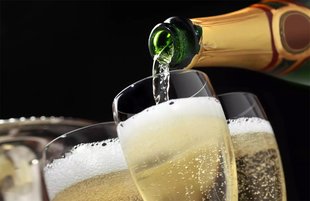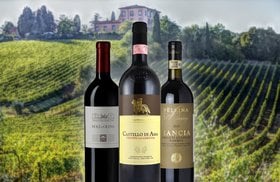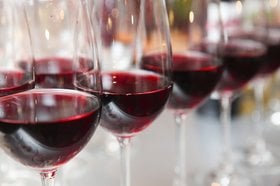Does Champagne Go Bad? 4 Warning Signs, Storage Tips
Yes, Champagne can go bad.
The lifespan of an unopened bottle depends on how you store it and whether it’s a vintage or non vintage Champagne.
And, if you don’t store your opened bottle of bubbly properly, it can quickly get oxidized, lose its fizz, and turn sour.
In this article, we'll look at why does Champagne go bad, signs that your Champagne has spoiled, if drinking spoiled Champagne is safe, and essential storage tips.
We'll also look at the difference between vintage and non vintage Champagne and the best age-worthy Champagnes.
Further reading
- If you've got a little Champagne left over, discover How to Keep It From Going Flat.
- Explore everything you need to know about Investing in Champagne and why it can be such a valuable asset.
Why Does Champagne Go Bad? (Opened Bottle vs. Unopened Bottle)
Champagne is a sparkling wine made exclusively in the Champagne region of France using Pinot Noir, Chardonnay, and Pinot Meunier grapes.
This wine style is just as sensitive to air, heat, light, and vibration as are all still white wine and red wine styles.
Let’s see what exactly causes Champagne to spoil:
1. Opened Champagne

An opened Champagne bottle can go bad due to oxidation. As oxygen interacts with Champagne, its breaks down the molecules and structure in the wine, creating a sour taste and unpleasant aromas.
To avoid oxidation, you should store Champagne in the fridge and drink it within 3-5 days of opening.
2. Unopened Champagne
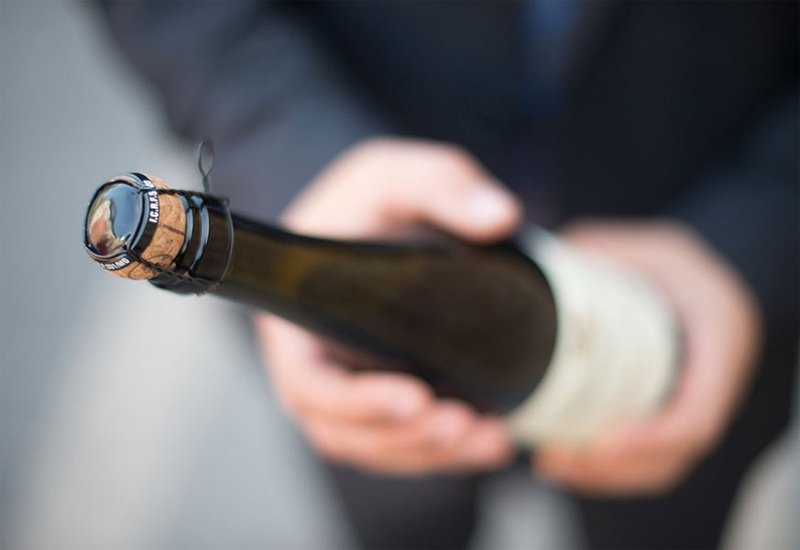
Two factors determine how long an unopened bottle of Champagne will last:
- Vintage vs Non Vintage:Vintage Champagne tends to have a lifespan of between 5 to 10 years, whereas non vintage Champagne typically has a shorter shelf life of about 3 to 5 years.
- Storage Conditions: Ideally, you should store your unopened bottle of Champagne at around 50°F to 55°F(10°C to 13°C). Exposing it to too much heat or light can cause it to go bad faster.
For example, you should avoid placing the bottle upright for extended periods of time. Over time, the cork can dry out and shrink, exposing your wine to oxygen.
Additionally, if the Champagne is exposed to light, heat, and vibration, it might lose its qualities and age prematurely.
4 Warning Signs That Your Champagne Has Gone Bad

Unfortunately, the best way to tell for sure if your Champagne has gone bad is to open the bottle. From there, look for these signs:
- Darker Color: The color is often the first sign that your Champagne has lost its oomph. A bottle of fresh Champagne has a beautiful pale golden color, while spoiled sparkling wine usually has a darker yellow color.
- No Popping Sound or Fizz: The iconic pop that comes with opening a bottle of sparkling wine, followed by a soft hiss, is the easiest way to tell if your bottle of bubbly is still good.
- Dry or Moldy Cork: Check the cork after you’ve opened your Champagne bottle. If it looks dry or moldy, it can cause the formation of clumps and cloudy sediment in the bottle. These signs indicate that your Champagne has spoiled.
- Sour Taste and Smell: A bottle of Champagne exudes bright, fruity aromas with floral fragrances. So, if your Champagne tastes or smells sour, it's most likely gone bad.
Can You Get Sick From Drinking Old Champagne?

A few sips of bad Champagne won't hurt anyone.
However, you still shouldn’t drink spoiled Champagne as it could cause an upset stomach.
If you’ve got some Champagne left and are not sure what to do with it, we’ve got some interesting ideas for you:
- Pour it into your pan to deglaze it after you’ve cooked something in it - like seared steak, or sautéed veggies.
- Add it to your tomato risotto.
- Make Champagne ice cubes.
- Freeze your flat Champagne in an ice tray and add it to your cocktails.
- Make Champagne vinegar by simply leaving your leftover Champagne to ferment for a few weeks.
Tips For Storing Champagne: Opened Bottle
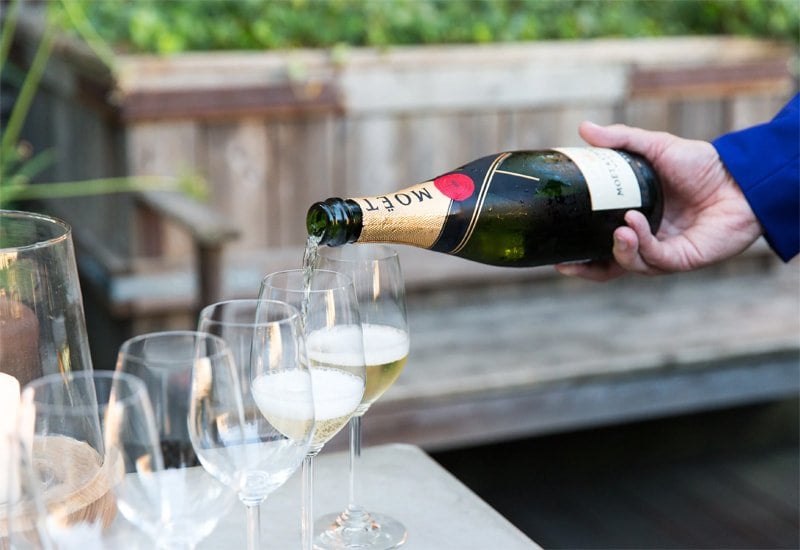
Once you’ve popped open a bottle of Champagne, you have a maximum of 3 to 5 days before it goes bad.
Here is how to store your opened bottle of Champagne correctly and preserve its bubbles:
- Reseal it Immediately: Make sure to reseal the open bottle tightly with a reusable cork, Champagne stopper, plastic wrap, or Champagne sealer as soon as you’re done serving.
- Keep it Chilled and Upright: Always store your opened Champagne bottle upright in an ice bucket or refrigerator to avoid any leakages and prevent loss of fizz.
Tips For Storing Champagne: Unopened Bottle
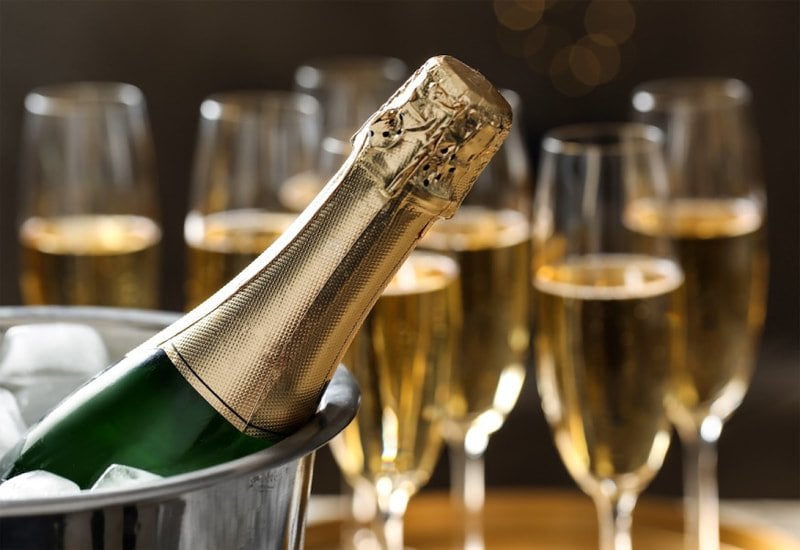
Here are some useful tips for preserving your unopened bottle of Champagne:
- Temperature: Store your Champagne bottle in a wine cellar or wine fridge at a consistent temperature of 40°F-60°F (4.4°C-15.5°C).
- Light: Keep your bottle away from direct sunlight and artificial light to prevent oxidation and change of color.
- Position: Store Champagne horizontally on a wine rack or wine shelf to keep the cork moist.
- Vibration: Keep your Champagne in a vibration-free environment (away from kitchen appliances, refrigerators, and stereo systems) to prevent the wine from aging prematurely.
Why Do Vintage Champagnes Last Longer Than Non Vintage Champagnes?

Let's see why:
- Grapes: Vintage Champagnes are made with high-quality grapes from a single year's harvest.
Non vintage Champagne is a blend of base wines from previous years.
- Aging Period: Vintage Champagnes must be matured for a minimum of 3 years before being released for sale.
A non vintage bottle of Champagne is matured for approximately 15-18 months.
The longer maturation period allows the wine to develop a more complex flavor over time, making it more age-worthy.
To understand whether you have a non vintage or vintage bottle of Champagne, check its label and see if it has NV (for non vintage) or the harvest year on it (vintage).
Fun Fact:Vintage Champagne is generally produced only three or four times a decade.
What Are the Best Age-Worthy Champagnes?

Certain luxury Champagnes have a shelf life of 20 years or more. These prestige Cuvees are aged longer before release and develop a more complex flavor and aroma.
Here are five of the best age-worthy Champagnes:
- 1928 Moët & Chandon Grand Vintage Brut ($3,320)
- 1928 Veuve Clicquot Ponsardin Vintage Brut ($1,809)
- 1967 Louis Roederer Cristal Millesime Brut ($2,012)
- 1949 Krug Collection Brut ($14,149)
- 1947 Pol Roger Vintage Brut ($3,000)
Additionally, the magnum wine bottle formats have a longer shelf life, making them more investment-worthy.
If you want to invest in age-worthy Champagnes, check out the Vinovest website.
With Vinovest’s advanced AI-based platform, you can buy, store, and sell Champagnes and other investment wines from across the globe.
Preserve Your Champagne’s Flavor And Bubbles

A glass of Champagne with lively bubbles and fresh fruit flavors is a great treat for any special occasion.
To ensure your Champagne is well-stored until it’s party time, just follow the tips we’ve just shared.
Meanwhile, if you’re looking for more investment-worthy Champagne bottles, hop onto the Vinovest wine investment platform and start building your wine portfolio.
